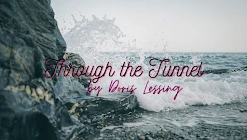Email:learnwith@introspectiveenglish.com
Physical address:
Durgapur, India


Prepare, Practise and Participate

Prepare, Practise and Participate

1. What does ‘Bonjour’ mean?
Ans: The word ‘Bonjour’ means ‘Good morning’.
2. What did Jerry’s mother carry?
Ans: Jerry’s mother carried a bright striped bag.
3. Why did Jerry go to the shore with his mother?
Ans: Jerry went to the shore with his mother to spend the holidays.
4. Which was the beach that Jerry knew from other years?
Ans: Jerry knew from other years about the crowded beach.
5. Who was staying underwater for a very long time?
Ans: The local boys of France were staying underwater for a very long time.
6. What was Jerry familiar with?
Ans: Jerry was familiar with the anxious, apologetic smile of his mother.
7. What did Jerry ask his mother to buy?
Ans: Jerry asked his mother to buy a pair of goggles.
8. How old is Jerry?
Ans: Jerry was eleven years old.
9. How did Jerry feel while entering the tunnel at first?
Ans: Jerry felt terrified but determined to get through the tunnel while entering it at first.
10. What did Jerry want to explore?
Ans: Jerry wanted to explore the wild bay.
11. What did Jerry do when he went to the beach the second time?
Ans: Jerry went to the wild bay and jumped off the promontories.
12. Why did Jerry clown around while the boys were diving by the rock?
Ans: Jerry clowned to have attention from the local boys of France. He tried to be funny as he realized he could not do what they were doing.
13. Why does Jerry leave his mother at the beach?
Ans: Jerry left his mother at the beach because he wanted to explore the other beach, and he also wanted to be independent.
14. Where did Jerry play in the morning?
Ans: Jerry played on the safe beach in the morning.
15.Why did Jerry need to buy a pair of goggles? Whom did he convince to buy them?
Ans: Jerry needed to buy a pair of goggles to see the opening of the tunnel.
He convinced his mother to buy them.
16.When did Jerry feel himself like an ‘inflated balloon’?
Ans: When Jerry started diving through the tunnel after preparing himself, at first, he felt like an “inflated balloon”.
1. When did Jerry cry alone and why? Why did Jerry hide his feat from his mother?
Ans: Jerry cried alone when Jerry could not dive through the tunnel and the local boys of France left the beach to get away from him.
Jerry was frustrated as his physical weakness and emotional weakness became an obstacle in the way of performing as the older boys performed. So he cried.
Jerry did not wish to worry his mother. Again, he wanted to prove to himself that he had the capability of conquering his fear, obstacles, and physical shortcomings, but did not think that his success needed to be known to his mother.
So he hid his feat from his mother.
2. How is Jerry’s wild bay different from his mother’s safe beach? What concerns did Jerry’s mother face while raising him?
Ans: Jerry’s wild bay is a more secluded and dangerous place which was unknown to Jerry whereas his mother’s beach is a crowded place, which was known to Jerry and his mother. Again, the bay was full of rocks, and it looked like a wild place where nobody was present, whereas the beach looked like a safe place.
Jerry’s mother faced some concerns while raising her son. She wanted to protect her son from all the dangers and wanted to make him happy. She was torn between letting him make decisions about what he liked to do and wishing to keep him close to her always.
3. Describe Jerry’s relationship with his mother at the beginning of the story. How did it change at the end of the story?
Ans: At the beginning of the story Jerry and his mother are dependent on each other, and they share a strong bond . On the first day of his vacation, Jerry plays on the safe beach where his mother stays with him. When his mother walks alone on the path, his contrition makes him run after his mother as he feels the need to be with his mother. As an obedient boy, he asks for permission from his mother to go to the wild bay. Again, when he fails to swim through the tunnel, he acts like a clown to get his mother’s attention.
At the end of the story, Jerry starts hiding so many things from his mother. Jerry trains himself to swim through the tunnel, he works very hard and faces a lot of challenges. He succeeds in accomplishing his ambition but does not reveal his successful adventure to his mother. It is the time when Jerry behaves like an independent boy, and his mother does not interfere in Jerry’s decisions, and actions a lot.
4. How was Jerry after he had completed swimming through the tunnel? What does ‘the tunnel’ symbolize?
Ans: After Jerry had completed swimming through the tunnel, he suffered extreme pain and his nose was so injured that it was bleeding. Jerry felt so satisfied as he proved his capabilities to himself. Then, he did not feel any need to swim through the tunnel again.
Jerry’s journey of becoming mature from immature is symbolized by the tunnel in the story ‘Through the Tunnel’.
5.Write a character sketch of Jerry.
Ans: Jerry is a well-mannered and calm boy who listens to his mother as an obedient son. He gets permission to go to the rocky bay from his mother. He likes to be a part of a group of native boys in France and finds out a Challenge while swimming through the tunnel. Though his failure makes him frustrated for a while, he does not break down for his failure.
He sets his goal and trains himself to fulfil his goal. He does a lot of practice holding his breath, bungs a pair of goggles, and surmounts all obstacles in the way of his goal with Courage and enthusiasm. At the end of his success, Jerry does not share his adventurous journey and achievement with others as he proves his capabilities to himself only.
6.Write a character sketch of Jerry’s mother.
Ans: Write a character sketch of Jerry’s mother. Ans: Jerry’s mother is a calm and compassionate woman who is a widow but a kind-hearted mother. There is no presence of a masculine figure in his life except her son. Her life revolves around Jerry and his upbringing. She takes care of his son but tries not to be overprotective of her son. She gives him enough space to grow up.
Though she worries about Jerry, she manages her emotions and lets Jerry enjoy his freedom, but sometimes she warns her by saying politely, “I shouldn’t overdo things, darling, if I were you”.
1.The young English boy stopped at a turning of the path. (Replace the underlined word with a phrasal verb)
Ans: The young English boy broke off at a turning of the path.
2.He had found the hole. (Change the voice)
Ans: The hole had been found by him.
3.He fix the goggles tight and firm. (Change to Past continuous tense)
Ans: He was fixing the goggles tight and firm.
4.He ran straight into the water. He began swimming. (Join into a Compound sentence)
Ans: He ran straight into the water, and he began swimming.
5.Have I been keeping him too close? (Change to past perfect tense)
Ans: Had I been keeping him too close?
A. Answer each of the following questions in a complete sentence:
1. What did Jerry tell his mother he would like to do?
2. Where does Jerry go on the second day of his vacation?
3. How is Jerry’s preparation, unlike the real test?
4. Which two areas of the coast does Jerry look at when he stands on the path?
5. Why does Jerry clown around while the boys are diving by the rock?
6. Why did Jerry decide that he must do what the other boys had done?
7. What was Jerry thinking of all morning while he played on the safe beach with his mother?
8. What do the local boys do whereas Jerry fails to do?
B. Answer each of the following questions in not more than 80 words each:
1. Describe what Jerry is experiencing during his journey.
2. Describe Jerry’s encounter with the local boys. What effect does it have on him?
Or,
Why was Jerry happy when he first joined them and how did he feel when he began diving with them?
3. How does Jerry prepare for his task?
4. Identify the internal and external conflicts Jerry faces in the story.
5. What are the major differences between the beach and the bay?
6. How has Jerry changed in the course of this story? Why is going to the bay “no longer least important”?
7. What must Jerry prove to himself by swimming through the tunnel?
9. What happens after Jerry returns to the villa?
10. What concerns does Jerry’s mother have about raising him? Why does Jerry’s mother think she must be careful?
11. Briefly summarize how Jerry finally swims through the tunnel. Why is the journey so dangerous?
Or,
The story ‘Through the Tunnel’ explores an individual’s search for identity and acceptance. Discuss with close reference to the text.
12. What does he feel when he finds the entrance to the tunnel and looks into it?
1. But the salt was so painful in his eyes that he could not see. (Change into an affirmative sentence)
2. She said to Jerry, “How did you bang your head?” (Change the narration)
3. He began splashing and kicking in the water like a foolish dog. (Replace the underlined word with a phrasal verb)
4. All night the boy dreamt of the waterfilled cave.(Expand with a Relative clause)
5. “Will you not accompany me dear ?” said the mother. (Change the narration)
6. He understood that he must swim down to the base rock from the surface of the water. (Replace the underlined word with a phrasal verb)
7. He pushed himself out backward and caught a glimpse, as he retreated. (Replace the underlined word with a phrasal verb)
8. He ran straight into the water. He began swimming. (Join by using Participle)
9. They looked down gravely, frowning. (Split into two sentences)
10. The boys were gathering up their bits of clothing. (Change the Voice)
11. The impact of the water broke the rubber-enclosed vacuum and the goggles came loose. (Change into a complex sentence)
12. He let himself down into the water with another big stone in his arms. (Rewrite using Relative clause)
13. As soon as breakfast was over, he went to the bay. (Change into a negative sentence)
14. He could see the local boys diving and playing half a mile away. (Split into two sentences)
15. Jerry was a good swimmer. (Change the adjective to the Superlative form)
Disclaimer: This content is created solely for educational and informational purposes. It draws upon publicly available educational materials, literary texts, and the author’s own interpretation. All summaries, analyses, and explanations are original and intended to support learning. No copyright infringement is intended.
Share this content: